Even though it was reasonably early when we got away from Turin and headed for Bologna, temperatures were already starting to climb . To the west between Turin and France, the land is very hilly, mountainous even. So we had not fully appreciated how flat the Po Valley is until we got on the autostrada. You only occasionally notice hills if the highway veers off to one side of the valley but that does not happen very often. The River Po starts in the hills to the west and south of Turin, is fed by the lakes in the north and runs all of the way east to the Adriatic, exiting north of Ferrara and Ravenna. There is a tremendous amount of cropping down through the valley, including corn, maize, rice, sun flowers, stone fruit and sugar beets. As we drove down the valley, we saw fields of sunflowers in the process of being beheaded, with the stalks being ploughed back under in readiness for the next crop. We stopped at an Autogrill en route for a coffee and while looking a little ordinary from the outside, they offer good simple food and excellent coffee. Watch where the truckies stop and you can't go too far wrong. We had downloaded a podcast by Rick Steves [an American travel writer] who happened to be interviewing Fred Plotkin, the author of our foodie bible and that added interest to both the book and our journey .
After a brief stop for a late lunch in Reggio Emelia [town is relatively modern and has very little in the way of special sights to attract travellers], we arrived at our next stopover – Bologna. Our accommodation is actually about six kilometres outside the city in a very quiet rural setting. Being on a side road in the country, we seldom see or hear any traffic. Landlord [Paolo] lives in the adjoining house. Nearby is a lovely country church which at 7.03 [night and morning] plays "Ave, Ave, Ave Maria" – definitely a lovely setting for sitting outside for our evening spritz/wine. Why three minutes past the hour, however, remains a mystery. Is it set to Vatican time? Is Vatican time set three minutes later than the rest of the world? Is the local priest's watch running slow? Are our watches three minutes fast? Time for another spritz while we ponder these heady questions.
Bologna itself has a number of claims to fame . It was a main Etruscan city and it was from here that the Etruscans expanded to the west and south in the BC centuries. Later, as is the way of the world, the Etruscans fell to the Gauls, who subsequently were done over by the Romans who in turn fell to the Lombards. Bologna has the oldest university in Italy (if not the world), dating back to 1088 and over the years many now famous students passed through its halls [including three Popes, Dante, Marconi and to our surprise, “our” very own Fred Plotkin.] The city has been re-born many times. The Etruscans tended to build their villages along the line of the Savena River which loops through the area. The Romans built a more secure walled city which then was expanded twice over the centuries as the city grew. There are still some gates in the inner city which have been incorporated into the surrounding buildings. As the city expanded, the walls in between the gates were probably raided for building material as new walls were created further out from the centre . Bologna is now no longer a walled city but the gates of the outer ring from the third period of growth have been retained as historic monuments. We actually drove the ring road one afternoon to "capture" [digitally] the remaining gates. [We are trying to be good little environmentalists by leaving only footprints and taking only photos.]
Like most other cities in Italy, Bologna clearly has its own identity. This probably comes from the fact that before unification, Italy comprised a large number of individual states, some aligned to the papacy while others were ruled by powerful families. Today, that individuality still shines through.
To quote Mary Jane Cryan, Bologna is not only “known as La Dotta (the wise) for its historic university ... and La Grassa (the fat) for its incredible cuisine, [but also] ... as the city where umbrellas are not needed, thanks to an ingenious network of covered side walks or porticoes.” Very handy again because the temperatures at the moment are in the mid to high 30s . We have noticed, however, the return of the locusts – those bus-loads of tourists with their “follow me” guides. Generally, when we see such a gathering, it is the signal to head in the opposite direction.
The other not generally known fact about Bologna is its towers. We first struck these in San Gimignano some years ago, but had not appreciated that they were also a feature further afield. Apparently, at their peak during the 12th and 13th centuries, there were about 180 towers of varying sizes in Bologna. Today, there are only about 20 with the most famous being the two in centre of the city "Due Torri" [two towers] - Asinelli and Garisenda. These leaning towers are often used as a symbol for the city. Because one leans to the left and the other to the right, one might infer that Bologna is a balanced city.
In our meanderings around the city, we kept striking impromptu buskers, ranging from a cello player, a harpist, a jazz group and finally, all the way up to a 10-strong Latin American group . This latter group drew the largest crowd [about 100] and obviously people were enjoying their performance because no one was moving on. They actually provided a counterbalance to a group nearby protesting injustice and corruption in government. This latter group had an extremely small audience in comparison. So I guess the song is right – let the music [take] your blues away.
The town is full of university students at the moment [no doubt a lot of them currently appearing as impromptu musicians] registering for the new academic year and seeking accommodation. Bologna must be a bustling city once the university year starts because the faculties are based throughout the city. Apparently, the medical school can also lay claim to having conducted the first formal dissection classes in Italy. A rather beautiful but scary austere room, fortunately with no blood on the floor these days.
Early in the week, we drove to Ravenna [pop ~160,000] . It had been on our pre-deployment list and was subsequently strongly recommended by our Mercallo host. Both of us were right. Ravenna was the capital city of the Western Roman Empire during the 5th Century until the Empire’s collapse. Over the next 400 years, control of Ravenna passed from the Ostrogoths [who had wandered out of their normal patch [today’s Ukraine] feeling the need to beat up on someone, so why not those chaps that had a good city and a link to the sea] to the Byzantines, to the Lombards, then a series of Popes before the Venetians decided they too needed a piece of the action. After a period of French intervention, the city switched back to being a papal state before eventually joining the newly forming nation of Italy in the late-1800s. [I guess these people can be forgiven for any confusion over who they really are.] Ravenna has a magnificent collection of mosaics in the various Byzantine-era churches still standing. We bought a group pass that enabled us to visit five churches/establishments in the city. The best are in the Basilica di San Vitale [and the immediately adjacent Mausoleo di Galla Placida] and the Basilica di Sant Apollinare Nuovo. Both basilicas date back to the 6th Century AD and even without the mosaics would be worthy of a visit as significant major structures in their own right. The craftsmanship of the mosaics, however, is simply superb [like Monet paintings but using 10 mm square patches of coloured tiles instead of paint].
To give you a better idea of what we saw in the Basilica of San Vitale, check out
< http://www .youtube.com/watch?v=kCLwAzrPiLk > [Italy Ravenna San Vitale Mosaics - attributed to Michael Grobman. He has done an excellent job of capturing the mosaics.]
He has also put one together for the Basilica Sant Apollinare Nuovo. See <http://www.youtube.com/watch?v=_3lJvch6b3U> [Italy Ravenna St Apollinare Nouvo Mosaics]
Over the weekend, we did two day trips:
- Abbazia di Monteveglio had not been on our list but was strongly recommended by our host here in Bologna. The town of Monteveglio is reasonably modern and very pleasant. However, the main attraction is the Abbazia [abbey], which sits high above the town and is the headquarters of a branch of the Franciscan order. There is a small community nestled within the walls [dating back to the 1100s] of the hilltop village together with a restaurant which gets tremendous write ups but regrettably [for us] only opens for dinners. There is a B&B establishment within the walls so if one was to visit the restaurant and imbibe [as all reviewers attested to] then we suggest you make a B&B booking as well. The road up to the top is very narrow and probably not one which should be tackled after a glass or two.
- Our other day trip was to Modena, the home of Enzo Ferrari, balsamic vinegar and that other famous son, Luciano Pavarotti. Modena had the usual mixed up beginnings for cities in this area involving the Villanovans, the Ligurians, the Etruscans and the Gauls before falling to the Romans. Over the next thousand years, it fell in [and out] with popes, dukes, and emperors [in no particular order] before falling under Austrian control where it remained until unification of Italy in the late-1800s. Today, however, Modena is better known for its connection to the motor industry or as stated by some[one], as "the capital of engines". Ferrari, De Tomaso, Lamborghini, Pagani and Maserati have/had factories/head offices here. Ferrari even named one of its cars, the 360 Modena, after the town. Regrettably, the day we visited they weren’t giving away free samples even though we did drive past their showroom. [As an aside, the day that we visited Modena, the Italian Grand Prix was taking place back in Monza just outside Milan.] The city also boasts its own leaning tower - La Ghirlandina [maybe they built them that way to attract the tourists] and the world’s oldest military academy established in 1678 preceding those of Russia [1717], England [1741], France [1750] and the USA [1804].
We indicated that we would have to do some serious tasting while here in Bologna . We feel we are now starting to become a little more familiar with the local cuisine, having sampled:
- Tagliatelle al ragu - a dish somewhat similar to a Kiwi bolognaise, but with a simple intensity. Egg pasta rather than the flour and water variety, and fresh in preference to dried pasta.
- Piadine with Prosciutto – another very simple but wholesome alternative fast food. A flat pancake with soft cheese, rocket and prosciutto, folded in half and warmed in a sandwich press.
- Tortelli di zucca a piacere – ravioli filled with squash cooked in a sage butter sauce
- Carpaccio con radicchio e sfoglie di Parmigiana Reggiana – thinly sliced raw veal with radicchio and shaved Parmigiano Reggiano dressed with a little olive oil and 15 year old balsamic. The latter was a thick syrup, smooth and rich. All together absolutely scrummy. [This and the Tortelli were sampled at Ristorante Da Enzo in Modena where the waiter also smuggled us two post-lunch digestivo – Sassolino [anise based] and Nocino [walnut based]. Both smooth but slightly breathtaking. The offer of more was reluctantly declined as we still had to drive home. This restaurant was also a favourite with Pavarotti so we were in good company, so to speak. Unfortunately, Pavarotti wasn't there the day we visited, having died six years earlier.]
- Assortment of bread and pastries – divine as usual. [Suspect the hoped for weight loss won’t kick in till much later in the journey.]
To date, we have clocked up over 2,700 kms. However, the longer legs are yet to appear. As part of the deal with the car, we are responsible for the cost of any routine servicing and with the first one due at 20,000 kms, it may be touch and go as to whether we have to have the car serviced before its return .
On our final day here in Bologna, we returned to the city for one brief experience - to climb to the top of the Asinelli Tower. 498 steps inside the tower and if you add the two off the adjacent road, a neat 500. The view from the top was splendid and gave us a much better feel for the size of Bologna and confirmed the presence of lots more towers most of which are not obvious at ground level because of the closeness of the buildings. We were obviously in better shape than we had imagined [and than some of those that we passed on the way up/down]. We were quite pleased with our efforts particularly since one of us has a significant birthday next week.
Back to that climb - it was not one for the faint-hearted. Not because of the challenging height of the climb [just over 97 metres], but because of the state of the steps getting you to the top. The wooden [first surprise] stairs run around the inside of the tower walls and are fixed on small platforms at each corner . The next surprise was the fact that the inner edge [ie, furthest side away from the external wall] of the stairs was frequently an inch or two lower than the side closest to the wall which distinctly left one feeling that sliding off into the central void was definitely an option. The next disconcerting part was the age of the stairs. Don't know how many feet go up and down them each day, but they are certainly wearing the treads thin and there were definite scallop shapes to the leading edge of each tread. The most alarming point, however, was the number of bearers [the parts that took the weight at each corner] that displayed significant borer infestation. [Hope you appreciate the photos and the hazards we have to face to bring Italy to your front room.]
Our time in Bologna has met our expectations regarding cuisine, culture and historic sights. Sadly, however, it is time to move on. Tomorrow, we start the trek southwards and for the next 11 days will reacquaint ourselves with the rolling hills of Tuscany .
But that will be a story for another day...

 Bologna, Emilia-Romagna, Italy
Bologna, Emilia-Romagna, Italy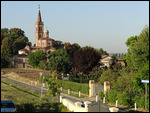

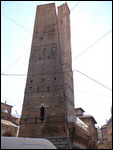
![Basilica of San Vitale [Ravenna]](http://images2.travelark.org/images/sntj/thumbnail.large.1.1370209473.basilica-of-san-vitale-ravenna.jpg)
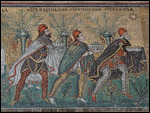
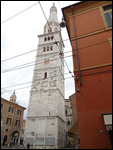
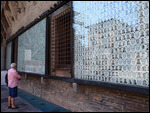
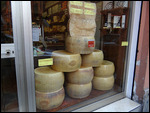
![Looking down on Garisenda Tower [Bologna]](http://images2.travelark.org/images/sntj/thumbnail.large.1.1370209473.looking-down-on-garisenda-tower.jpg)


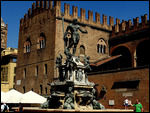





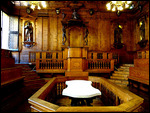
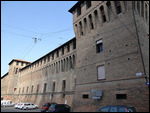
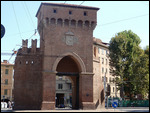

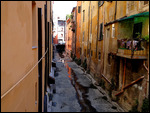


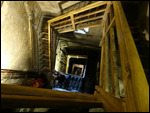
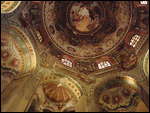
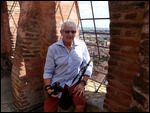
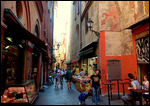
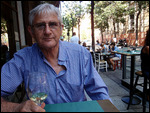

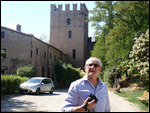
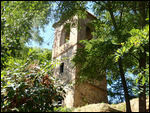
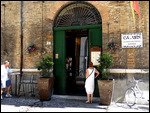
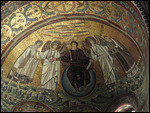
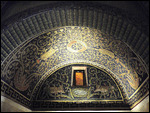
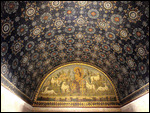
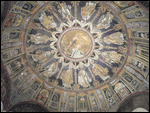
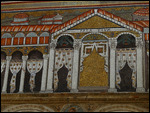
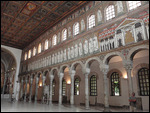
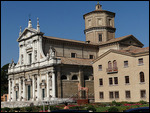
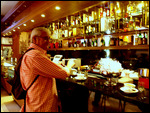
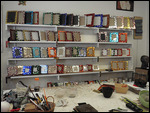
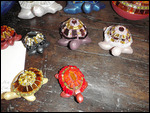
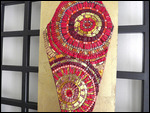
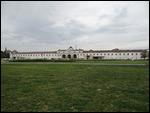




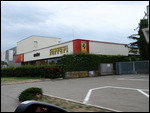

2025-05-23